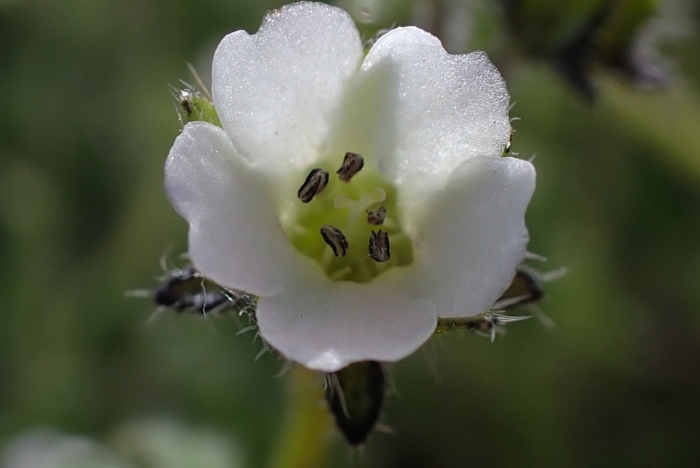Racemed Fiestaflower
(Pholistoma racemosum)
Racemed Fiestaflower (Pholistoma racemosum)
/
/

Madeleine Claire
CC BY 4.0
Image By:
Madeleine Claire
Recorded By:
Copyright:
CC BY 4.0
Copyright Notice:
Photo by: Madeleine Claire | License Type: CC BY 4.0 | License URL: http://creativecommons.org/licenses/by/4.0/ | Rights Holder: Madeleine Claire | Publisher: iNaturalist | Date Created: 2021-03-17T10:43:46Z |



















































Estimated Native Range
Summary
Pholistoma racemosum, commonly known as Racemed Fiestaflower, is an annual herb that is native to a variety of habitats including chaparral, grasslands, oak woodlands, and coastal sage scrub in California, as well as the Mexican Pacific Islands and Northwest Mexico. It typically grows up to 60 centimeters in length with a fleshy, bristly stem that branches profusely, sometimes creating a tangled appearance. The foliage is distinctive with its rough, hairy texture. The inflorescence of Racemed Fiestaflower is notable for bearing clusters of 2 to 6 flowers, each up to a centimeter long and 1.5 centimeters wide. The flowers are white to blue with five rounded lobes and bloom in the spring, adding a delicate touch to the plant’s overall appearance.
Racemed Fiestaflower is appreciated for its unique flowers and ability to thrive in shaded conditions, making it suitable for part shade to full shade garden spots. It requires medium amounts of water and prefers well-draining soils. While not commonly used in cultivation, it can be an interesting addition to native plant gardens or naturalized areas. Gardeners should note that it may self-seed and spread if conditions are favorable. Due to its annual nature, it does not pose long-term problems with aggressive roots or invasiveness.CC BY-SA 4.0
Racemed Fiestaflower is appreciated for its unique flowers and ability to thrive in shaded conditions, making it suitable for part shade to full shade garden spots. It requires medium amounts of water and prefers well-draining soils. While not commonly used in cultivation, it can be an interesting addition to native plant gardens or naturalized areas. Gardeners should note that it may self-seed and spread if conditions are favorable. Due to its annual nature, it does not pose long-term problems with aggressive roots or invasiveness.CC BY-SA 4.0
Plant Description
- Plant Type: Herb
- Height: 1-2 feet
- Width: 0.2-0.5 feet
- Growth Rate: Moderate
- Flower Color: White, Blue
- Flowering Season: Spring
- Leaf Retention:
Growth Requirements
- Sun: Part Shade, Full Shade
- Water: Medium
- Drainage: Fast
Common Uses
Bee Garden, Butterfly Garden, Low Maintenance, Potted Plant
Natural Habitat
Native to chaparral, grasslands, oak woodlands, and coastal sage scrub in California, the Mexican Pacific Islands, and Northwest Mexico
Other Names
Common Names: Racemose Fiesta Flower, San Diego Fiestaflower
Scientific Names: , Pholistoma racemosum, Nemophila racemosa, Nemophila erodiifolia, Ellisia racemosa, Viticella racemosa,
GBIF Accepted Name: Pholistoma racemosum (Nutt. ex A.Gray) Constance